This post may contain affiliate links. Please read our disclosure policy.
Learn how to make hickory-smoked vegan cheese from scratch! Prepared with 5 simple ingredients, this vegan cheese is naturally fermented and smoked over hickory wood chips for complex flavors. It’s buttery, packed with umami and so warming!
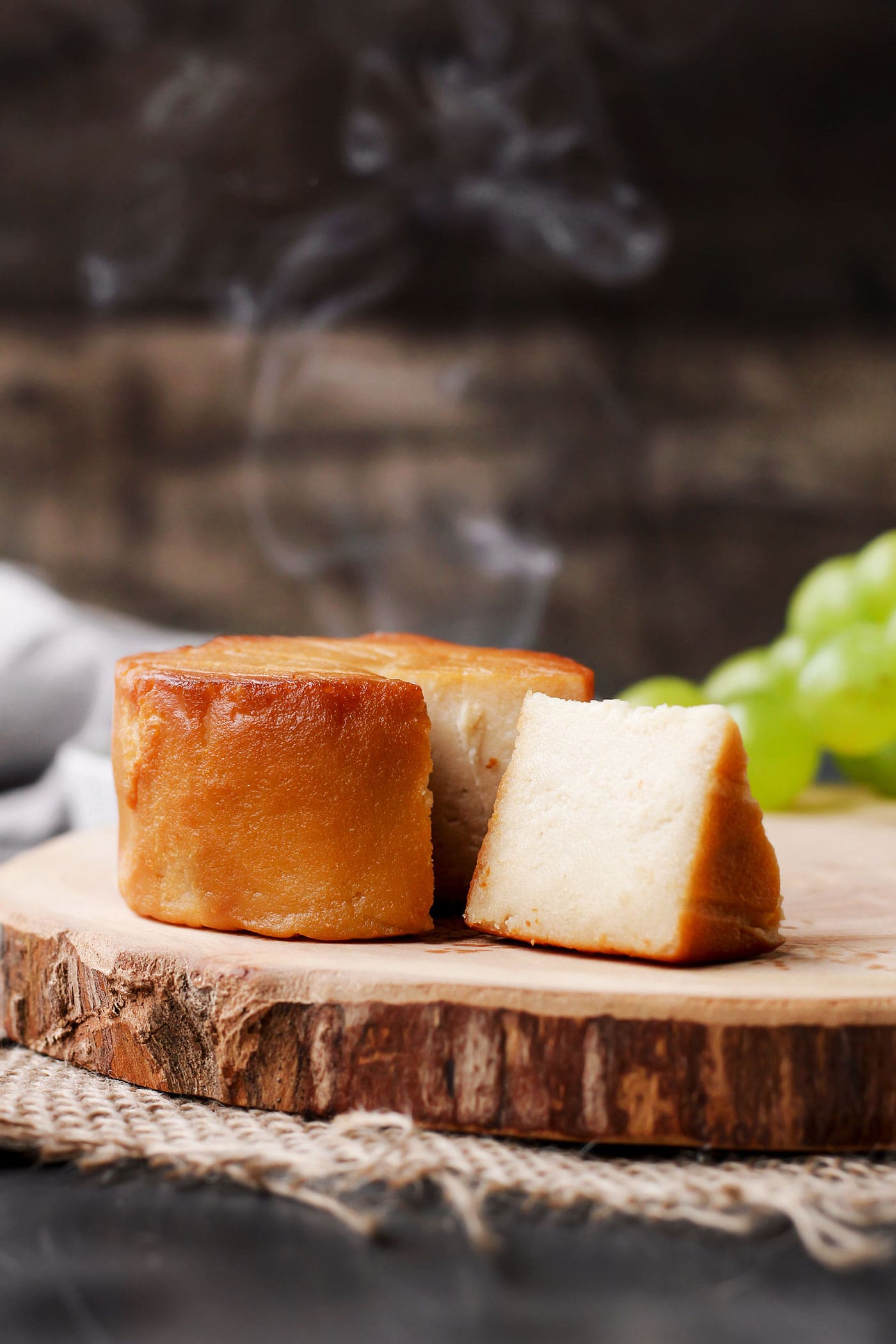
I’m so excited to share this recipe with you, friends. I have been making this hickory smoked vegan cheese for years and it’s still one of my favorites.
I can’t find words powerful enough to express my love for this cheese. Honestly, I love it EVEN MORE than my camembert and blue cheeses, even if they take more time and effort to make. There is just something about it, maybe the comforting smoky smell, the strong umami flavor, or its golden brown color, but this cheese just hits me. And I’m sure you will love it too if you give it a try!
⭐️ Why You Should Try It
Infused with the most warming smokiness.
This is the kind of cheese that brings back memories of smoked cheddar or even bacon. This smoked cheese is seriously delicious. The natural smoking process gives it a warm, comforting flavor you can’t get with flavorings like liquid smoke or smoked salt, for example.
It’s incredibly savory, bold, and cheesy. It’s so rustic that I could imagine that cheese on Bilbo’s table in Hobbiton, served alongside some drinks and loaves of freshly baked bread.
Months of development.
After releasing my camembert and blue cheese recipes, I wanted to work on something a bit different, where there would be no mold required. Since I used to be a huge fan of smoked cheeses such as smoked raclette or gouda, I decided to come up with my own version of smoked vegan cheese.
It took me months of experimenting with various ingredients and processes, but I finally achieved the exact flavor I was aiming for.
Made with simple, wholesome ingredients.
The advantage of this recipe is that it doesn’t require any specific mold or hard-to-find ingredients. All you need are cashews, white miso, nutritional yeast, and acidophilus (or mesophilic culture). Compared to my previous cheese recipes, you don’t even have to take care of the temperature or humidity that much.
You just have to be patient as this smoked cheese is aged for a total of three weeks, smoked after two, and edible one week after the smoking process. If you can wait for one to two additional weeks, it will be worth it, as the flavors gain in complexity as time passes.
Plus, if you can age it for the total recommended time, it becomes sliceable. It’s firm on the edges and just slightly tender on the inside, like real dairy cheese!
The reviews speak for themselves.
Over the last few years, my smoked vegan cheese recipe has received over 60 reviews with an average of 5 stars! People have posted their results on Instagram, Facebook, and other social platforms and they LOVE this cheese!
🌰 Ingredient Notes
Here are the ingredients that you will need to make this smoked cheese:
Cashews
Raw cashews make the base of this cheese recipe. I love to use cashews to make vegan cheese as they help create a rich and creamy mouthfeel. On top of that, cashew cream ferments really well and firms up as it ages.
Please note that I haven’t tried this recipe with other nuts so I cannot give you recommendations. This recipe cannot be made nut-free either.
White miso
My first tests only included cashews and cultures, and I realized something was missing. Miso came to the rescue to add plenty of umami, a subtle sweetness, and extra saltiness that balances beautifully with the bold smokiness.
Note: You should absolutely use sweet white miso for this recipe. This type of miso is generally less salty, sweeter, and softer compared to other kinds of miso.
Nutritional yeast
Nutritional yeast adds an extra kick of cheesiness and umami. I do not use a lot, just enough to sublimate the cheese’s natural tanginess.
Acidophilus
Instead of relying on vinegar or lemon juice to add tanginess, I like to use real cultures that will allow the cashew cheese to ferment naturally. You can use either acidophilus capsules or mesophilic cultures, which are made specifically for cheese making.
If using Acidophilus, use the powder contained in 8 capsules. If using mesophilic culture, use about 1/8 teaspoon.
Salt
Salt is an essential ingredient in cheese making. It prevents bad mold and bacteria from growing, pulls out excess moisture from the cheese, enhances its flavor, and extends its shelf life.
Note: I recommend using regular table salt for this recipe. Himalayan salt, because of its color, will make it hard to know if there is bad mold growing on your cheese or not.
🥣 How to Make It
1. Blend the cashews
- Soak the cashews. Add the raw cashews to a large bowl and cover them with water. Let the cashews soak overnight or for at least 8 hours.
- Drain them. The next day, drain the cashews and transfer them back to the bowl.
- Cover with boiling water. In order to kill possible harmful bacteria, I recommend bringing a pot of water to a boil and pouring it over the cashews. Let sit for 1 minute, and drain them again. Next, allow the cashews to cool down for 15-20 minutes.
- Blend into a cream. Transfer the drained cashews to a high-speed blender or food processor. Add the white miso, nutritional yeast, and filtered water. Blend on high speed, scraping down the sides from time to time, until you get a very smooth yet thick texture.
Adjust the water: If needed, add an extra tablespoon of water at a time until the cashew cream is smooth. DO NOT add too much water, though – you want to use as little as possible. Otherwise, the cheese will be too soft, and you won’t be able to shape it into wheels.
- Add the culture. Stir in the acidophilus powder from the capsules (or use mesophilic culture) and blend again for a few seconds.
2. Ferment it and shape it into wheels
- Allow the cashew cream to ferment. Transfer the cashew mixture to a cheesecloth and wrap it tightly (alternatively, you can use a nut milk bag). Place the cheesecloth containing the cashew cream in a colander on top of a bowl. Add a weight above it and let sit at room temperature for about 24 hours. Regarding the weight, I usually just place a plate and a few bowls on top but feel free to use whatever you have on hand.
This step is important to start the fermentation of the cashew cream and drain possible excess water (which will make it easier to shape the cream into wheels). - Check after 24 hours. After one day, give the cashew cream a taste. It should have a slightly sour and lemony taste, like fresh cream cheese.
- Refrigerate. Transfer the cashew cream to a clean bowl and cover with plastic film to the touch. Place in the refrigerator for about 4 hours.
- Shape into small wheels. Cut strips of parchment paper and lay them in three 4-inch springform pans. You want to cover the sides and bottom of the springform pans. You can also use plastic film if you prefer. The goal is to prevent the cheese from sticking to the metal. Fill the pans with the cashew cream and press it down using plastic film so it doesn’t stick to your hands. Cover the pans with plastic film touching the cashew cream (to prevent it from drying) and place in the refrigerator for 2 days.
- Salt. Two days later, carefully remove the cheeses from the springform pans and place them in a container lined with parchment paper. Salt both sides of each cheese with about 1/4 tsp of salt per cheese. Slightly salt the sides as well. Use your finger to gently spread the salt on the surface of the cheeses.
- Refrigerate. Cover the container with its lid and refrigerate for 24 hours.
- Pat them dry. The next day, your cheeses will have lost some water due to the salt. This reaction is called osmosis. Basically, salt drains excess water. If they are too wet, pat them dry with a paper towel and replace the parchment paper with a new one.
3. Let them age
- Age the cheeses. For the next 2 weeks, flip the cheeses every day and change the parchment paper regularly if it becomes wet. Note: Your cheeses should always be aged in your refrigerator, inside the container. Not at room temperature. At first, the cheeses will be very soft, but as they age, they will become firmer. If you see some mold appearing, just scrape it off and re-salt the area.
This two-week aging process will allow your cheeses to firm up and develop flavors. After this process, they should be firm enough to handle and ready to smoke. Note that it is normal for your cheeses to turn slightly off-white/yellow, as you can see in the photos.
4. Smoke
After two weeks, your cheeses should be firm enough to handle. If they are not, I recommend letting them age for another week. Once they are firm enough, it’s time to smoke them! To do so, I used a Camerons stovetop smoker. It’s a simple tool that allows you to smoke foods on the stovetop. Here is how to smoke your cheeses:
- Set up. Place one tablespoon of hickory wood chips in the bottom of the stovetop smoker. Place the drip and cooking trays on top of the wood chips. You can now place two cheeses on the cooking rack.
- Smoke. Heat the smoker over low-medium heat on a stovetop burner. Once the smoke starts to appear, close the smoker’s lid completely and smoke the cheese for about 12 minutes. Some smoke will escape from the smoker. That’s normal.
- Flip. Halfway through smoking, carefully flip the cheeses. This will not affect flavor, but it will allow your cheeses to get an even brown color.
- Allow to cool. After 12 minutes, the cheeses should be golden brown. Remove the smoker from heat and let cool for at least 30 minutes. Note: The cheeses will be very soft because of the heat, so remove them very carefully from the rack.
- Age them again. Transfer the cheeses to a bamboo mat or clean grid and place them in the refrigerator. Let them age for one more week, flipping every 2-3 days. If you are patient enough, I recommend allowing the cheeses to age for another 2-3 weeks after the smoking process, wrapped in cheese paper (the flavors will merge, and the cheeses will become even firmer).
Why wait after smoking? I recommend letting them age for another 2-3 weeks after the smoking process, as this allows the flavors to merge and mellow down. Right after smoking, the smoky taste is very strong, almost bitter. Allowing the cheeses to age for a minimum of 7 days will remove that bitterness.
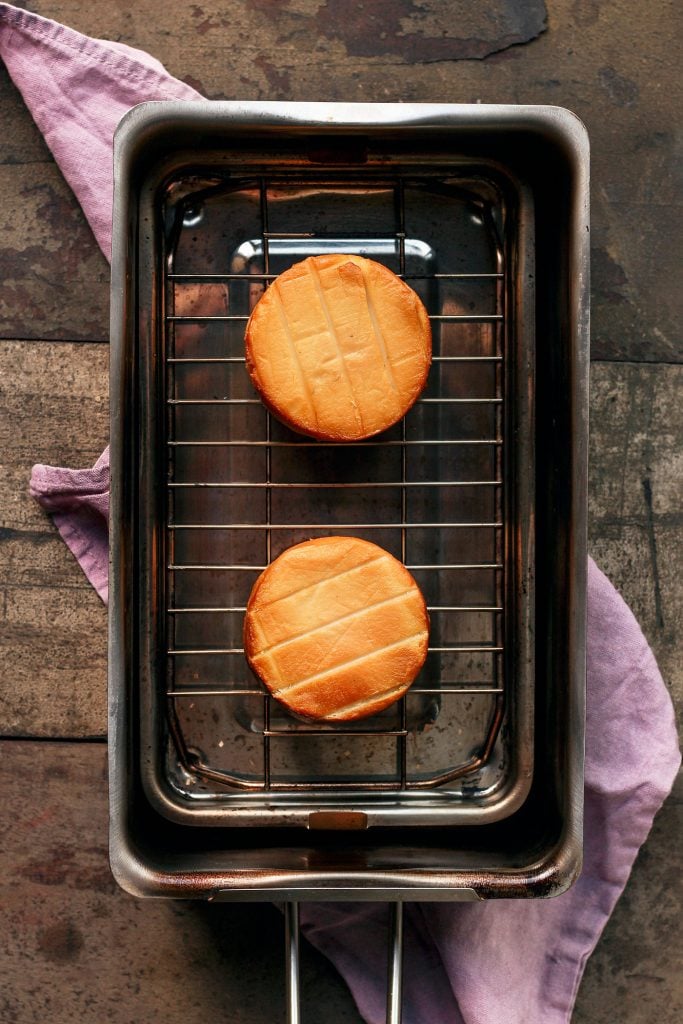
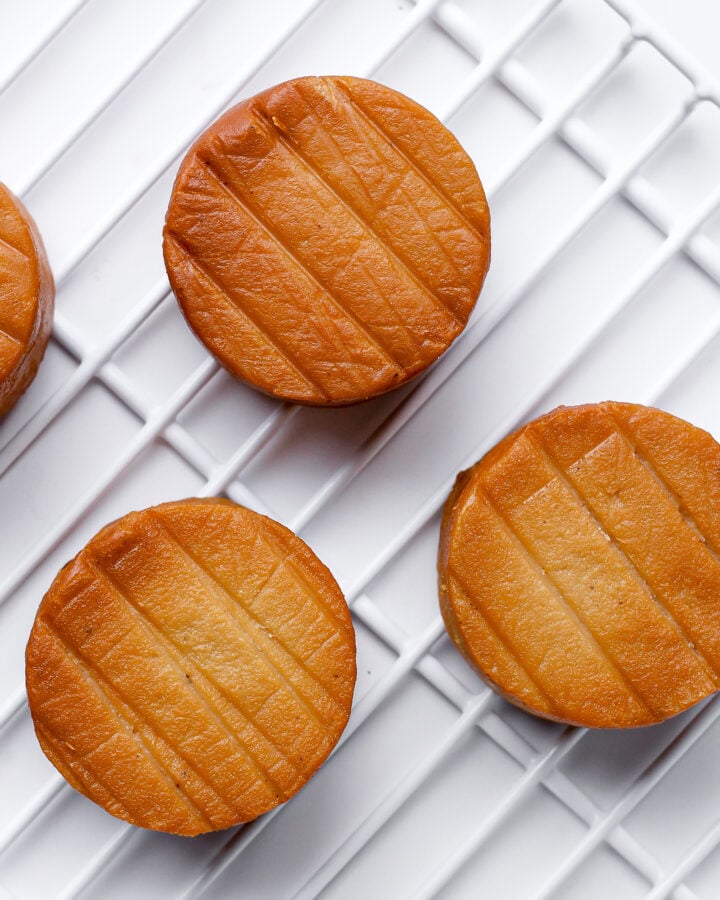
📔 Tips
- Use clean utensils. Hygiene is important in cheese making. Hence, it is essential to use clean utensils and containers while making this recipe. I also highly recommend wearing gloves when handling the cheeses to prevent them from growing bad mold or bacteria.
- Be patient. This is not one of those 10-minute cheese recipes. This cheese takes time to age, to firm up, and to develop its flavors so I recommend being patient and enjoying the process. I assure you it’s completely worth it!

🥖 What to Serve It With
You can serve this smoked cheese on its own or:
- As part of a cheese platter: with roasted nuts, dried fruits, jam, or apple slices.
- With bread: It goes very well with whole wheat bread, toast, and crackers.
- In other recipes: you can even use it in other recipes like burgers, sandwiches, bánh mì, etc. It can also be blended with milk or cream to make a fantastic salad dressing!
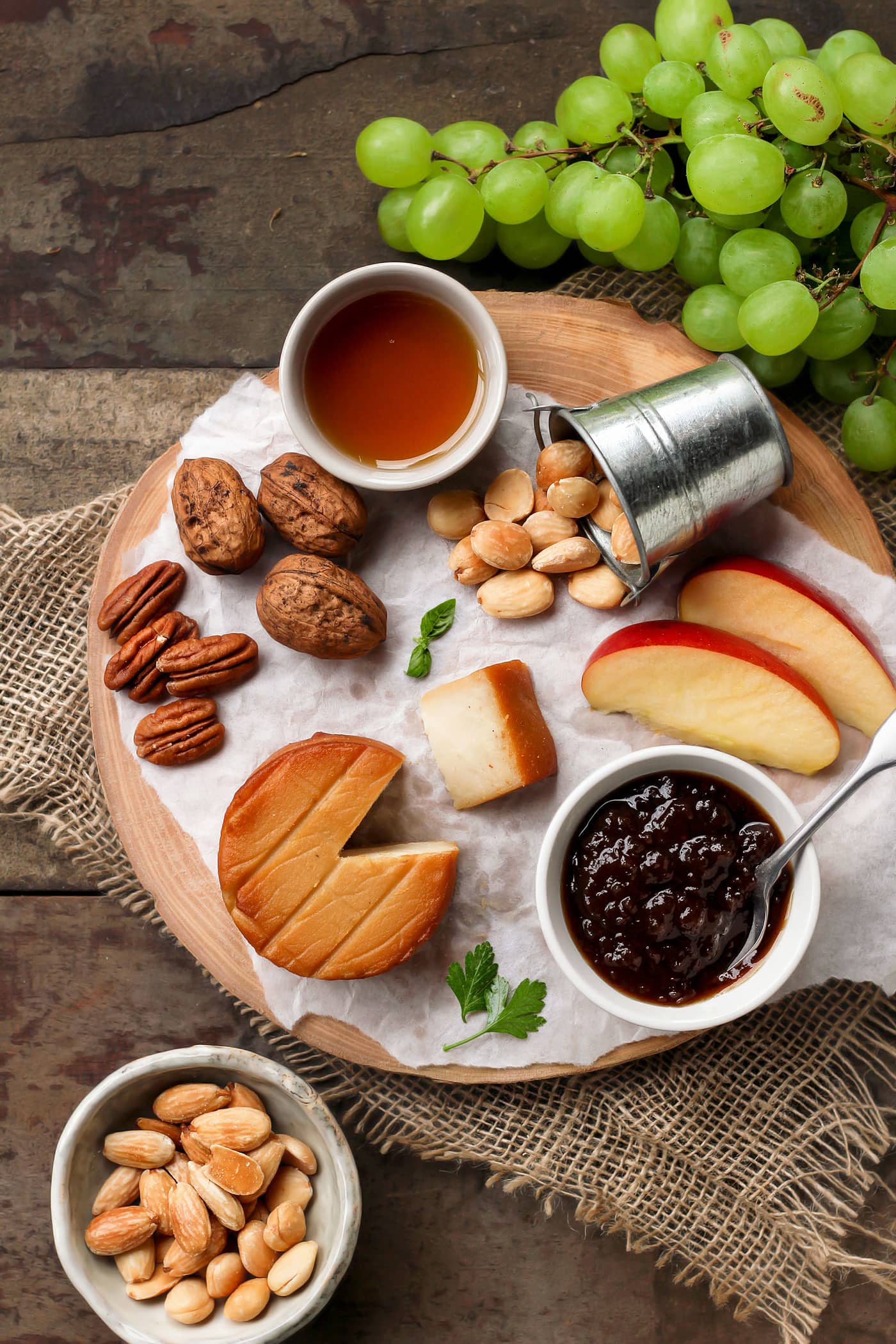
❄️ Storing and Freezing
- To store: After the smoking process, this cheese can be stored in the refrigerator for up to four weeks. If you see any sign of mold, simply scrape it off.
- To freeze: You can freeze this cheese for up to 3 months. Thaw overnight in the refrigerator.

💬 FAQ
It can be normal for your cheese to develop a thin layer of white mold, especially in the early stages of aging. In that case, use a thin knife to scrape off the area and resalt it. Alternatively, you can simply brush the mold with a brine. The salt should keep it from growing again.
Once you have salted the cheeses, it is completely normal for them to release water. It will actually help them firm up. Use kitchen paper towels to absorb the excess moisture in the container.
Yes, you can smoke this cheese in a cold smoker for 45-90 minutes, depending on how smoky you want it to be.

I hope you will love this cheese as much as I do. It’s incredibly smoky, buttery, and packed with umami. I have shared this cheese with many people, non-vegans included, and it has always been a hit!
🧀 More Vegan Cheese Recipes
⭐️ Did you like this recipe? Let us know in the comments below, and tag us on Facebook, Instagram, or Pinterest!
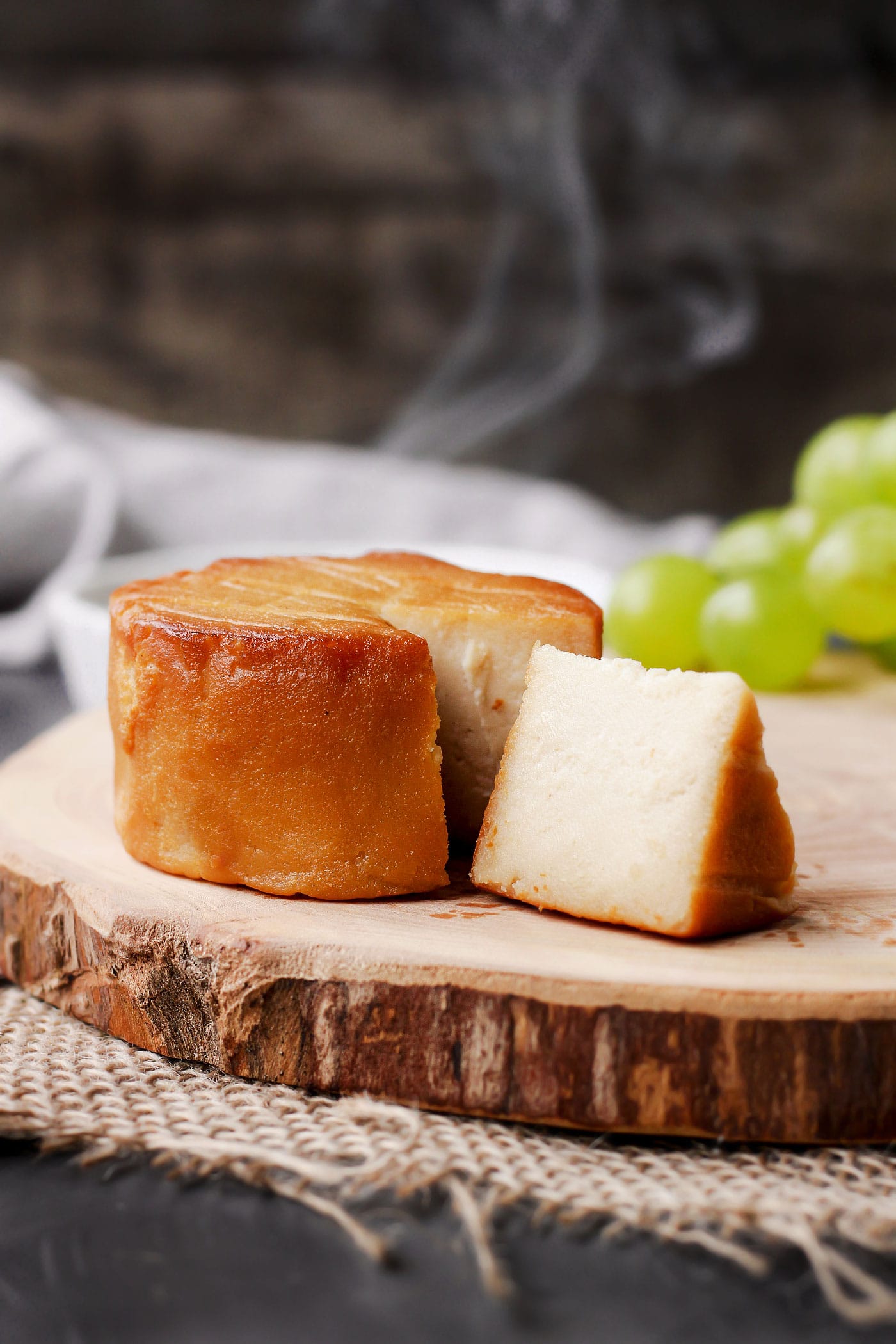

Save this recipe!
Enter your email below and I’ll send it to your inbox!
Plus, you will receive new recipes every week!
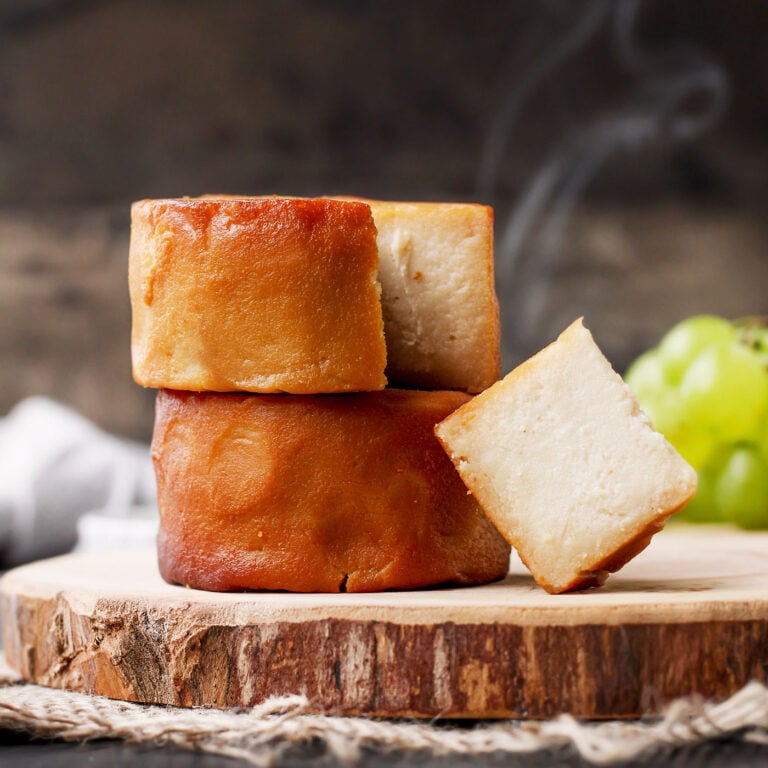
Hickory Smoked Vegan Cheese
Equipment
Ingredients
- 4 cups (600 g) raw cashews soaked overnight
- 3 tbsp (51 g) sweet white miso
- 3 tbsp (21 g) nutritional yeast
- 4 tbsp (60 ml) filtered water
- 8 capsules acidophilus or 1/8 tsp mesophilic culture
- sea salt
- 1 tbsp hickory wood chips
Instructions
Blend the cashews
- Soak the cashews. Add the raw cashews to a large bowl and cover them with water. Let the cashews soak overnight or for at least 8 hours.
- Drain them. The next day, drain the cashews and transfer them back to the bowl. In order to kill possible harmful bacteria, I recommend bringing a pot of water to a boil and pouring it over the cashews. Let sit for 1 minute, and drain them again. Next, allow the cashews to cool down for 15-20 minutes.
- Blend into a cream. Transfer the drained cashews to a high-speed blender or food processor. Add the white miso, nutritional yeast, and filtered water. Blend on high speed, scraping down the sides from time to time, until you get a very smooth yet thick texture.
- Add the culture. Stir in the acidophilus powder from the capsules (or use mesophilic culture) and blend again for a few seconds.
Fermenting and shaping
- Allow the cashew cream to ferment. Transfer the cashew mixture to a cheesecloth and wrap it tightly (alternatively, you can use a nut milk bag). Place the cheesecloth containing the cashew cream in a colander on top of a bowl. Add a weight above it and let sit at room temperature for about 24 hours. Regarding the weight, I usually just place a plate and a few bowls on top but feel free to use whatever you have on hand. This step is important to start the fermentation of the cashew cream and drain possible excess water (which will make it easier to shape the cream into wheels).
- Check after 24 hours. After one day, give the cashew cream a taste. It should have a slightly sour and lemony taste, like fresh cream cheese.
- Refrigerate. Transfer the cashew cream to a clean bowl and cover with plastic film to the touch. Place in the refrigerator for about 4 hours.
- Shape into small wheels. Cut strips of parchment paper and lay them in three 4-inch springform pans. You want to cover the sides and bottom of the springform pans. You can also use plastic film if you prefer. The goal is to prevent the cheese from sticking to the metal. Fill the pans with the cashew cream and press it down using plastic film so it doesn’t stick to your hands. Cover the pans with plastic film touching the cashew cream (to prevent it from drying) and place in the refrigerator for 2 days.
- Salt. Two days later, carefully remove the cheeses from the springform pans and place them in a container lined with parchment paper. Salt both sides of each cheese with about 1/4 tsp of salt per cheese. Slightly salt the sides as well. Use your finger to gently spread the salt on the surface of the cheeses.
- Refrigerate. Cover the container with its lid and refrigerate for 24 hours.
- Pat them dry. The next day, your cheeses will have lost some water due to the salt. This reaction is called osmosis. Basically, salt drains excess water. If they are too wet, pat them dry with a paper towel and replace the parchment paper with a new one.
Aging
- Age the cheeses. For the next 2 weeks, flip the cheeses every day and change the parchment paper regularly if it becomes wet. Note: Your cheeses should always be aged in your refrigerator, inside the container. Not at room temperature. At first, the cheeses will be very soft, but as they age, they will become firmer. If you see some mold appearing, just scrape it off and re-salt the area.
Smoking
- After two weeks, your cheeses should be firm enough to handle. If they are not, I recommend letting them age for another week. Once they are firm enough, it’s time to smoke them.
- Set up. Place one tablespoon of hickory wood chips in the bottom of the stovetop smoker. Place the drip and cooking trays on top of the wood chips. You can now place two cheeses on the cooking rack.
- Smoke. Heat the smoker over low-medium heat on a stovetop burner. Once the smoke starts to appear, close the smoker’s lid completely and smoke the cheese for about 12 minutes. Some smoke will escape from the smoker. That’s normal.
- Flip. Halfway through smoking, carefully flip the cheeses. This will not affect flavor, but it will allow your cheeses to get an even brown color.
- Allow to cool. After 12 minutes, the cheeses should be golden brown. Remove the smoker from heat and let cool for at least 30 minutes. Note: The cheeses will be very soft because of the heat, so remove them very carefully from the rack.
- Age them again. Transfer the cheeses to a bamboo mat or clean grid and place them in the refrigerator. Let them age for one more week, flipping every 2-3 days. If you are patient enough, I recommend allowing the cheeses to age for another 2-3 weeks after the smoking process, wrapped in cheese paper (the flavors will merge, and the cheeses will become even firmer).
- After the smoking process, this cheese can be stored in the refrigerator for up to four weeks. If you see any sign of mold, simply scrape it off.
Notes
- Use clean utensils. Hygiene is important in cheese making. Hence, it is essential to use clean utensils and containers while making this recipe. I also highly recommend wearing gloves when handling the cheeses to prevent them from growing bad mold or bacteria.
- Be patient. This is not one of those 10-minute cheese recipes. This cheese takes time to age, to firm up, and to develop its flavors so I recommend being patient and enjoying the process. I assure you it’s completely worth it!
Nutrition

About the Author
Thomas Pagot is the founder, photographer, and recipe developer behind Full of Plants. He created the blog in 2016 as a personal cookbook for vegan recipes. Through years of recipe development, Thomas has successfully grown Full of Plants into a trusted resource for plant-based recipes.



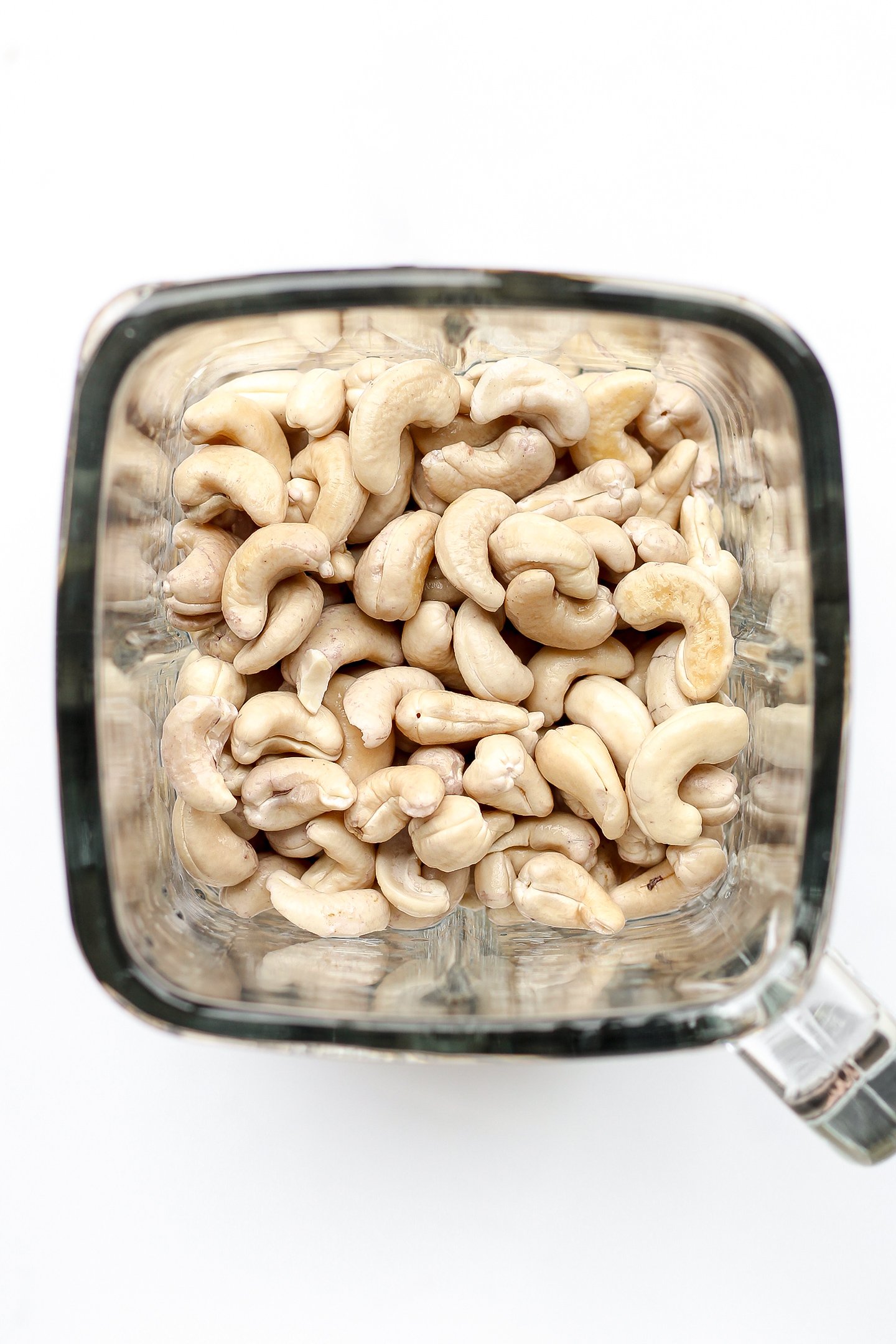
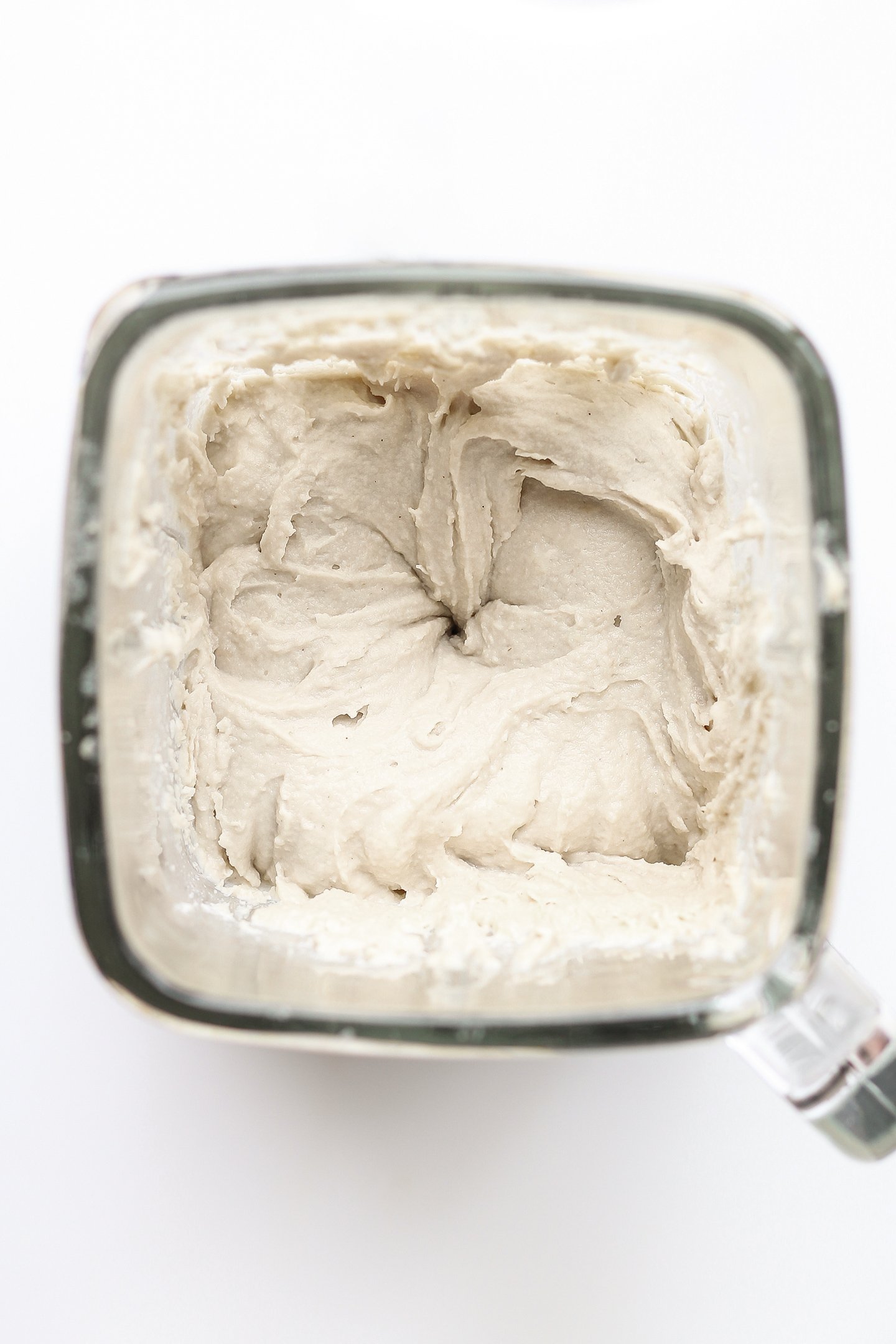
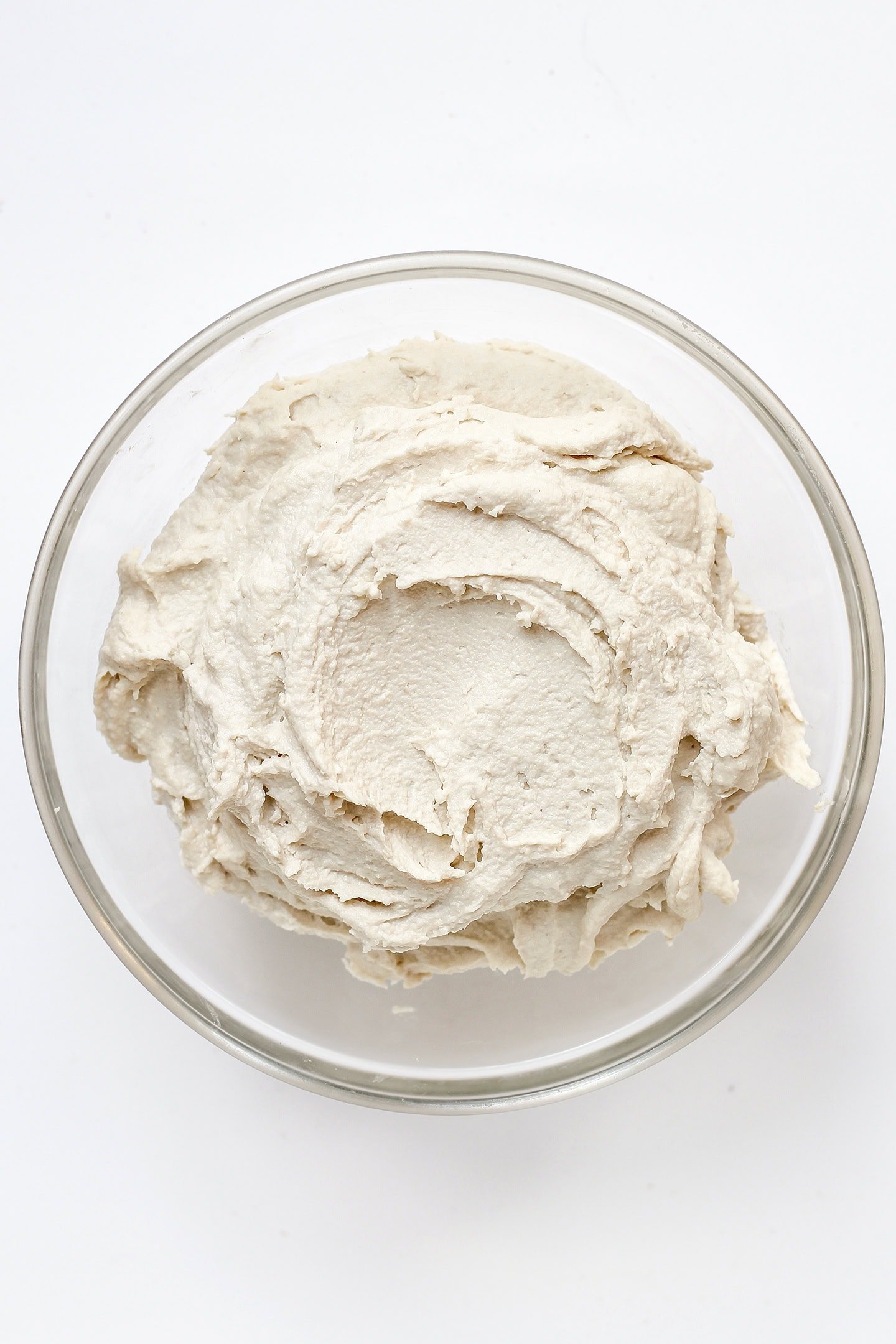
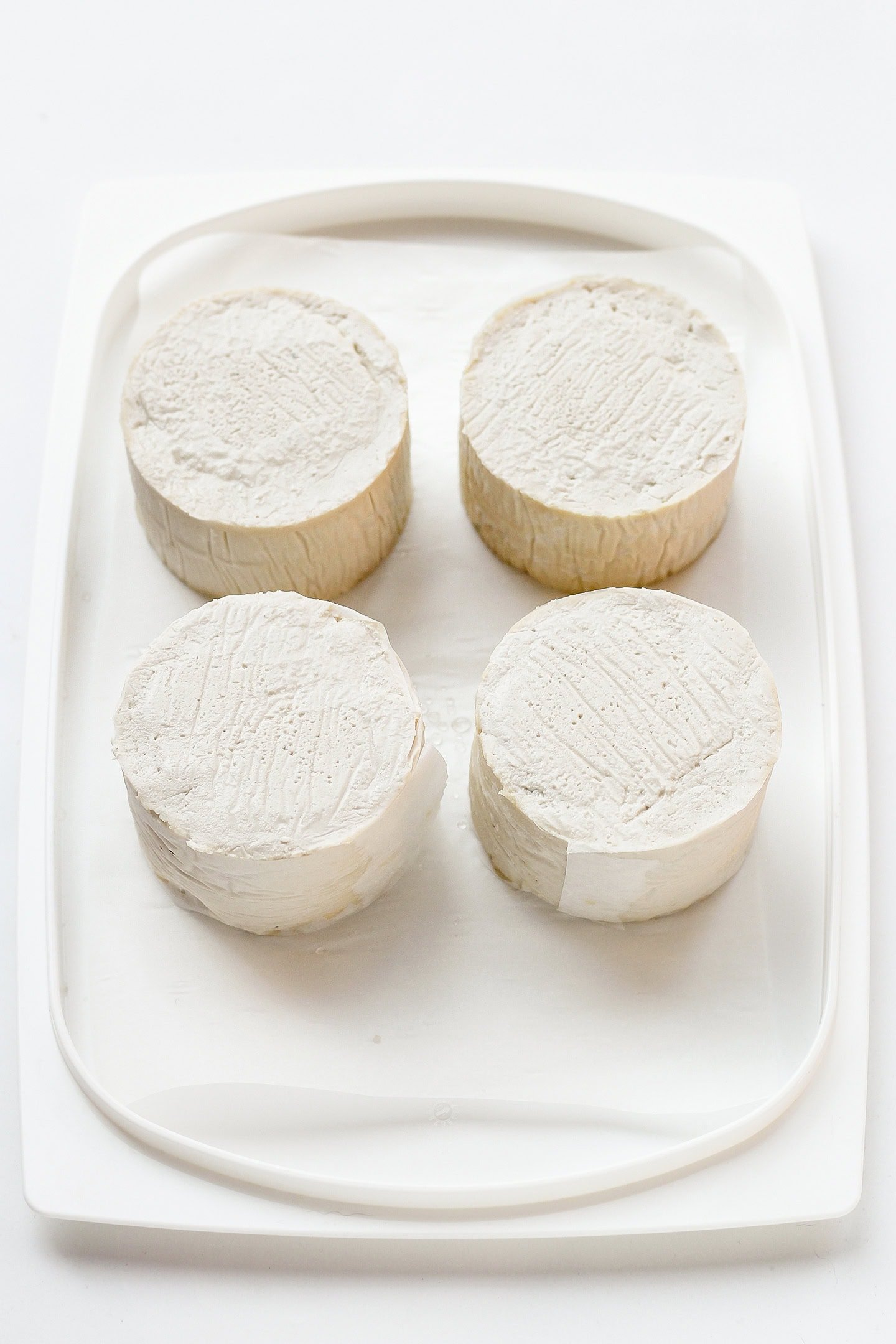
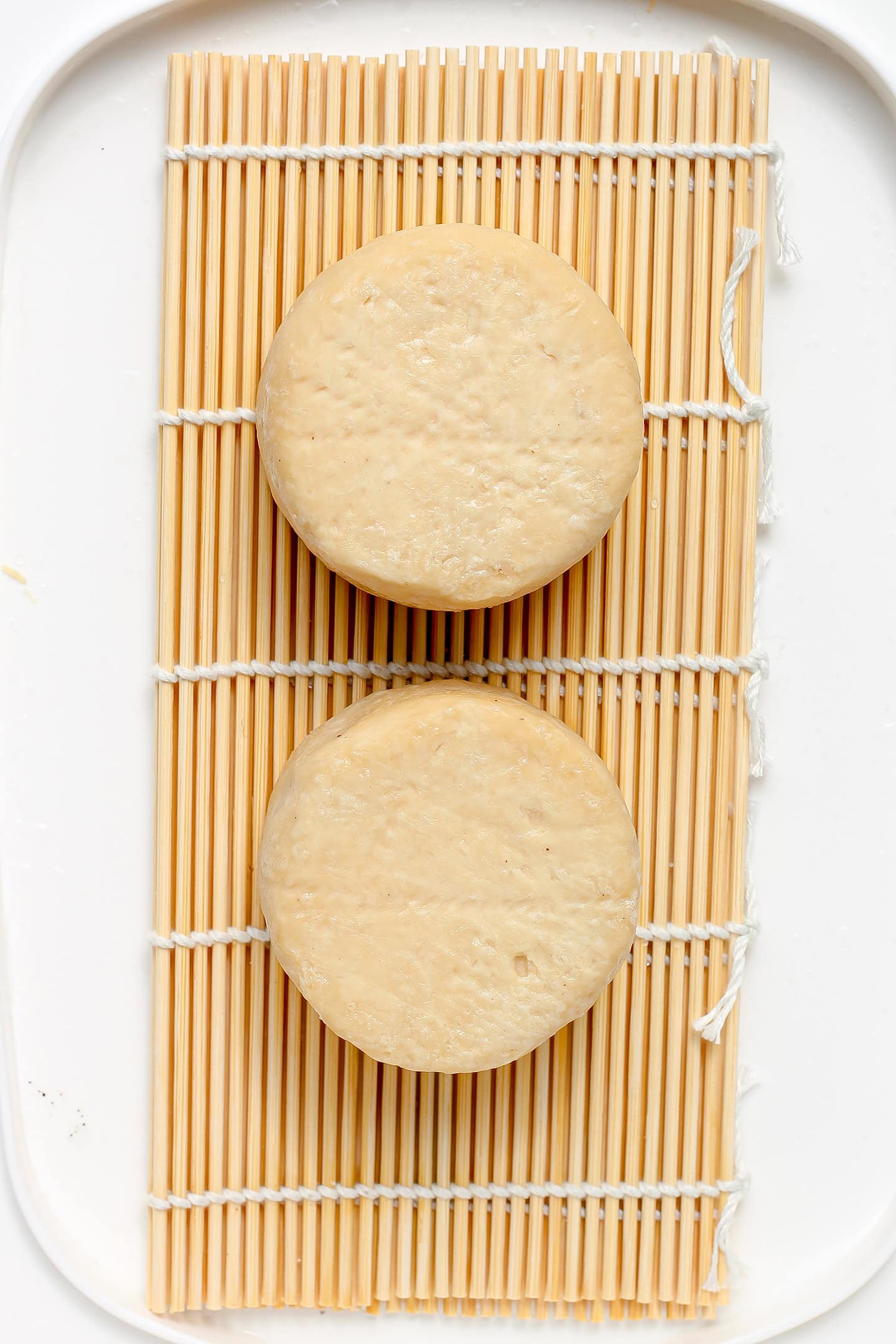


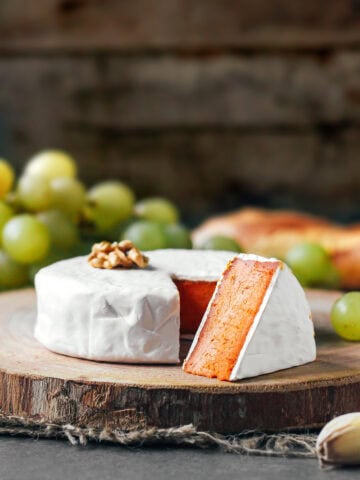
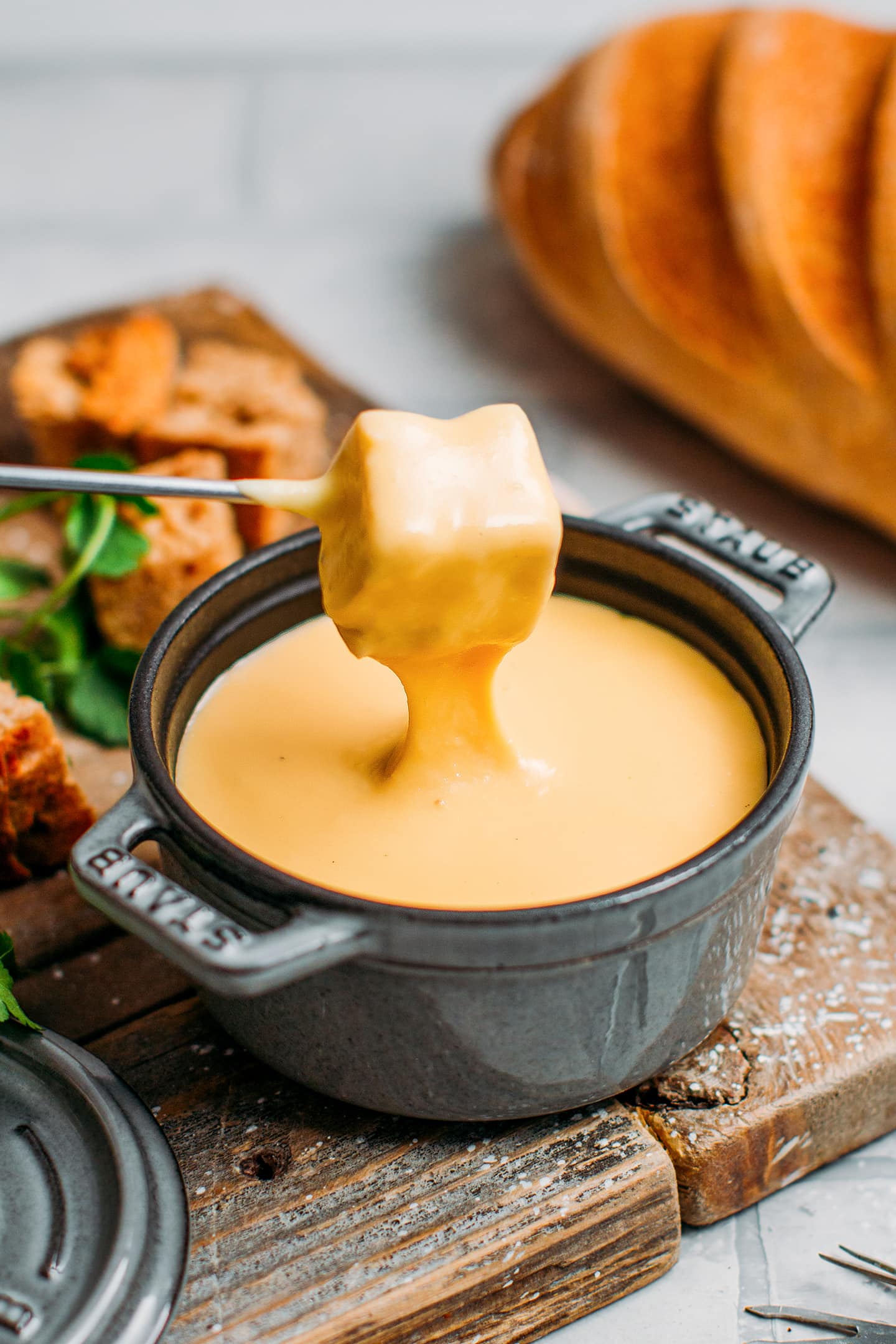

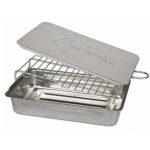
Leave a Comment
I wanted to try this cheese without smoking it. So I planned on aging it a bit longer for more flavours. But after 3 weeks it started to smell like acetone. I’ve decided to toss it, because it also tastes like acetone.
I really want to try this recipe again, but I don’t know what to do different. I used vegan mesophilic cultures. Should I try it again with acidophilus cultures? Should the aging container be air tight? Or was my fridge too cold/warm?
Hi Anika,
If your cheese smells like acetone, it definitely turned bad. Mesophilic cultures should work well, I always use that.
I guess your fridge may have been a bit too warm or some contamination happened during the process. Next time, boil the water and let it cool down completely before blending it with the cashews. Also you may want to try pouring boiling water over the cashews, letting them sit for 1 minute and drain. Then allow to cool completely before blending. One more thing, try using gloves when handling the cheeses. Hope this helps!
I’ve made these soooo many times. Always a show stopper!
I usually substitute the water for lemon juice. It gets extra tangy and cheesy in my opinion 🙂
So glad you enjoyed the smoked cheese, Bianca! It’s one of my favorites too—I’m a big fan of anything smoky. Thanks so much for your feedback!
Made this for the second time this year. Still so in love! Totally worth the wait. Thanks for the awesome recipe Thomas!
You’re welcome Jessica! I’m happy to hear you had success with this recipe 🙂
Do you think the vegetable steamer which you can put in a pot instead of smoker?
Do you mean putting the wood chips inside a steel pot and placing a steamer with the cheeses on top?
I’m unsure if that would work to be honest as I have never tried. There are, however, some tutorials online on how to make a homemade smoker using a pot and some aluminum foil, you might want to check them out.
about to start making your Camembert tonight or tmrw and thinking of trying this one next. Would this cheese be good and still have an interesting flavor without smoking it? I don’t mind the curing process, just not a huge fan of smoked cheeses. Also, I’m curious how firm this cheese is? I’m interested in finding something on the harder side though I saw you mention in another comment that you haven’t had much luck with hard cheese. Thanks for the recipes!!
Yes, the cheese still tastes great without the smoking step. The firmness of the cheese will depend on how long you let it age. It can get very very firm after 3-4 months.
How long is it safe to cure the cheese before smoking… i had 10 days of turning it everyday, but then i went on a trip and left it for 2 weeks untouched…came back…it still smells good…but still is too soft in my opinion, since i started with softer mixture i think 🤔 so now it’s been almost a month
As long as there are no sign of mold, it can be aged for 2-3 months easily, even more for a harder cheese.
Hi Thomas, thanks for sharing this amazing recipe, it looks amazing! I am in the process of making it, but I have a question about the smoking process. Do you recommend any particular size for the smoking chips? Or any is fine? And also, I read on the package that they need to be soaked in water before placing them in the stovetop smoker, do you suggest following this step or not? Thank you so much!!
Hi Ilaria, any smoking chip works fine. I have used fine powder as well as larger “chips” and got great results both times.
I am unsure about soaking as I have never done that, I place them directly into the smoker without soaking them before.
Thomas, I love your determination about and dedication to making vegan cheeses! I would say that cheese is the food I’ve missed the most since going 100% plant-based with my eating.
The cheese-making processes (for this and all the other cheeses you do) are fascinating and definitely more specialized than, say, making a dinner dish. You’ve certainly put a ton of work into developing them!
Alas, I don’t know that I’ll get around to making them, given the special ingredients, tools and the ‘active waiting’ times. But I’m giving it a 5-star rating because I can see the recipe and process are solid.
However, maybe you should consider making them for sale? They sure beat what goes for ‘vegan cheese’ in the markets! And I suspect I’m not the only plants-based eater who craves a good, aged cheese.
Thank you Yodan!
It’s true, cheese-making is very different from making any other recipes as there are many critical steps and care that must be given in order to achieve successful results. However, it’s not as challenging or as difficult as it looks like, so I hope you can give it a try someday 🙂
Thanks so much for sharing this! I made a cheese cave! I have made a batch of the hickory but I don’t like the flavor of the smoke. and left the cheese in the cave to get more taste. I do see appearances of white mold, for now I’m scraping and putting salt on it, but is this ok? is that mold safe?
Yes, it’s okay, just scrape it off and resalt the area. White mold is safe. Pink, brown or black mold is not.
Hi Thomas, Thanks for sharing all these amazing vegan cheese recipes!
Do you believe I could replace the springform pans from step 6 with a cheesecloth lined in a bowl?
Hi Bruna,
The springform pans are just used to shape the cheeses, so you can use bowls, ramekins, or any other dish!
I just had my first bite of this cheese and it was worth the wait! Tastes just like Miyoko’s Aged Smoked English Farmhouse. Actually… it’s a little better!
I bought a smoker just for this (same as the one you have, btw).
I’m also almost done with a batch of camembert and blue cheese.
In a couple of weeks, I’ll have some friends over and we’ll enjoy all these 3 cheeses along with your cheese fondue.
Can’t thank you enough!
I’m so happy to hear you liked this smoked cheese, Bianca!
Yes, a smoker is so worth it! I hope you can also use it for other foods too, as it’s a fantastic tool 🙂
Good luck with your camembert and blue cheese 😉
I’m making your camembert, blue cheese, and hickory smoked cheese all at the same time! You made me buy a smoker, my friend… haha
I have made camembert and blue cheese in the past, but I had trouble with growing the mold. Your instructions were really clear, so I’m having a lot more success this time.
I got a fridge thermometer to keep an eye on the temperature around the cheeses and the mold is growing beautifully!
I’ll tag you on IG when they’re ready to show you the pictures.
have you ever tried liquid smoke instead? Thank you
You could use that but the flavor will be different. The real smoking process brings a deeper, more woody aroma.
Hi. Thanks so much for this please tell me what I may substitute for nutritional yeast in this recipe.
Thanks, Tess
Hi Tess,
I would simply omit it as there are no good substitutes.
My absolute favorite cheese to make. It is delicious. Finally I dont miss cheese from dairy anymore, all because of this recipe. All my non-vegan friends and family adore it as well. Thank you so much for sharing Thomas.
You are welcome Eliseba! Thanks for your rating 🙂
Can i make the cheese in the instant pot? And if so how would it work? Thanks
I’m afraid I do not understand what you mean by making the cheese in the Instant Pot. You do not require any cooking for this recipe.
Hi Thomas. I have probiotic powder only. Will this be ok and if you possibly know, how much to us. Thanks
Hi Claire,
The problem is that all probiotics are different, so I cannot say if it will work for sure. Regarding how much to use, check how strong yours are and compare it with the ones I recommend, then you can adjust the amount.
I make mesophilic yogurt, could I use some of that to culture and what would the measurement be as opposed to using powder ?
I think that should work! I would probably use about 1 teaspoon.
Thomas,
For the Hickory Smoked Vegan cheese, when making this recipe, for refrigeration – should the cheese be aged at 50 to 55 degrees, or can it go in the regular refrigerator with the temperature in the low 40s?
Also, it appears that this recipe can be left open on a plate as opposed to in a covered storage container – is this correct?
Hi Cathy,
For this recipe, cheeses can be aged in a regular refrigerator and left uncovered (it’s okay that the exterior dries out). Be aware that because the temperature is lower, the cheeses might take much longer to harden than at a higher temperature.
Update on Sunflower Seeds – it works really well. The cheeses lose a lot of water during the initial aging, so I kept them on kitchen towel in a closed container, and changed the towel daily. They firmed up very well and smoked very well. The only downside for me personally is there was a strange after taste – which I suspect is the natural taste of the sunflower seeds, as opposed to anything bacterial or “off”. So if you like Sunflower seeds and/or looking for a nut free alternative, it’s worth a try. I’m trying almonds next.
Thanks for sharing your experiments Esther!
I can imagine what you mean by the stranger after taste, I find that in sunflower seed butter as well.
Hi Thomas! I love your vegan cheeses recipes, they are clear and easy. I’m hoping to start making my own aged cheeses and I wanted to start with a super simple one. I was thinking to replicate this recipe but without the smoking process. Should I follow the same steps but omitting the smoking part? Do I need to have something in mind to prevent any mold to grow on the surface of the cheese? Thank you for your knowledge!!
Hi, great recipe! I’m hoping to start making mi first batch of aged cheeses, and I’m really excited!! But I think that the best way to start is making a simple recipe cheese without the smoking step just to practice. Do I have to follow the same steps but omitting the smoking process? Or do you recommend something to prevent any mold to grow on the surface of the cheese? Thank you for the amazing knowledge!
Hi Maxi,
Well, the smoking part is probably one of the easiest 🙂 Otherwise, yes you can simply omit it and follow the recipe as is, no need to change anything (you shouldn’t have mold growth).
Hi Thomas, I have successfully made this recipe in the past, and adore it – thank you. I’ve just started more a Keto eating plan, so I’m going to try it with Sunflower Seeds, and will report back on my success!
Hi Esther,
Looking forward to know how it turns out!
Hi Thomas!
I can’t wait to start making your cheeses! I am new to vegan cheese making. I do want to ask if you have a cheddar recipe?
Hi Renee,
I do not have any cheddar recipe, sorry! Despite doing multiple trials, I never had any success with hard cheeses.
This recipe is great. It stays really well in fridge or frozen and thawed. I made this Christmas last year 2021 for charcuterie board and have the last of it in my fridge as we speak. No mold, and not stale one bit.
Aged for around 50days in total (including after being smoked). Making another batch currently 👍
Awesome! Glad you liked this cheese recipe, Hayley!
Long term storage? Can this cheese be frozen? I am making this now, so I will come back and rate the recipe later.
I personally haven’t tried freezing vegan cashew cheeses, but some readers reported they had great results doing so.
For the hickory chips…do you soak them in water before adding to the smoker or just add them dry?
No need to soak the hickory chips before using.
Thomas, can you clarify why you have to wait 2 weeks to smoke this cheese?
It’s 1) To let the cheese dry a bit and harden and 2) To let flavors develop.
Thank you for your speedy reply. I will be patient and wait the 2 weeks.
When this cheese is aging in the fridge does it need to be covered like the blue cheese does? I didn’t see in your instructions where it was covered while on the plate aging.
I would recommend covering the cheeses in you are aging it in your regular fridge (to prevent bad mold from growing). However, if you are aging it in a separate fridge, you do not have to cover it. As opposed to the Camembert and Blue Cheese, this cheese won’t get a mold on its surface, so it doesn’t need too much humidity.
Hi! every time I make a cheese, the surface cracks. Which may be due? Thank you so much!
Hi Pili,
I would guess it’s because the cheeses dry too quickly, try keeping the cheeses in a container, and maybe slightly lower the temperature of your fridge.
Thank you very much for answering. I’ll change the temperature of the fridge!